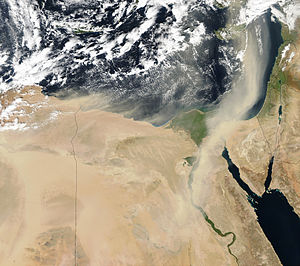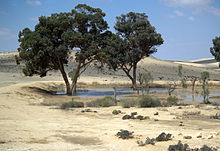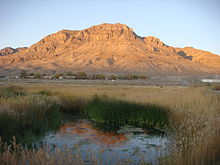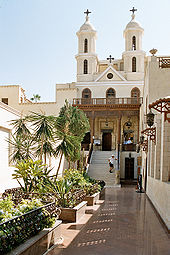 The Nile is a major north-flowing river in northeastern Africa, generally regarded as the longest river in the world. It is 6,650 km (4,130 miles) long. The Nile is an "international" river as its water resources are shared by eleven countries, namely, Tanzania, Uganda, Rwanda, Burundi, Democratic Republic of the Congo, Kenya, Ethiopia, Eritrea, South Sudan, Sudan and Egypt.[4] In particular, the Nile River provides the primary water resource and so it is the life artery for its downstream countries such as Egypt and Sudan.[5]
The Nile is a major north-flowing river in northeastern Africa, generally regarded as the longest river in the world. It is 6,650 km (4,130 miles) long. The Nile is an "international" river as its water resources are shared by eleven countries, namely, Tanzania, Uganda, Rwanda, Burundi, Democratic Republic of the Congo, Kenya, Ethiopia, Eritrea, South Sudan, Sudan and Egypt.[4] In particular, the Nile River provides the primary water resource and so it is the life artery for its downstream countries such as Egypt and Sudan.[5]The Nile has two major tributaries, the White Nile and Blue Nile. The White Nile is longer and rises in the Great Lakes region of central Africa, with the most distant source still undetermined but located in either Rwanda or Burundi. It flows north through Tanzania, Lake Victoria, Uganda and South Sudan. The Blue Nile is the source of most of the water and fertile soil. It begins at Lake Tana in Ethiopia at
12°02′09″N 037°15′53″E / 12.03583°N 37.26472°E and flows into Sudan from the southeast. The two rivers meet near the Sudanese capital of Khartoum.
The northern section of the river flows almost entirely through desert, from Sudan into Egypt, a country whose civilization has depended on the river since ancient times. Most of the population and cities of Egypt lie along those parts of the Nile valley north of Aswan, and nearly all the cultural and historical sites of Ancient Egypt are found along riverbanks. The Nile ends in a large delta that empties into the Mediterranean Sea.\
This is a list of rivers in Egypt.
There is only one year-round river in Egypt, the Nile. It has no non-seasonal tributaries for its entire length in Egypt, though it has two further upstream, the Blue Nile and White Nile, which merge in central Sudan.
In the Nile Delta, the river splits into a number of distributaries and lesser channels. In ancient times there were seven distributaries, of which only two are extant today due to silting and flood relief schemes; from east to west, they were:
- the Pelusiac,
- the Tanitic,
- the Mendesian,
- the Phatnitic (extant; now the Damietta or Damyat),
- the Sebennytic,
- the Bolbitinic,
- the Canopic (extant; now the Rosetta or Rashid).
- Wadi Abbad (drainage area 7,000 km²)
- Wadi Shait (length 200 km, drainage area 10,000 km²)
- Wadi El-Kharit (length 260 km, drainage area 23,000 km²).
Current lakes
Aswan (Nasser) Lake
A vast reservoir in southern Egypt and northern Sudan. Behind the High Dam of Aswan on the river Nile, contains river water.
Manzala Lake
Salt or brackish water lake. In northeastern Egypt on the Nile Delta near Port Said, Damietta, Dakahlyia and Sharqyia governorates.
Marriotiya Lake
A salt lake in northern Egypt, between Alexandria and Al-Buhira (Beheira actually is named after it) Governorates.
Lake Bardawil
Salt water Lake in North Sinai Governorate. It is said that it is named after King Baldwin I of Jerusalem of the First Crusade and that he was buried there.
Lake Moeris or Qaroun Lake
Brackish water Lake. South River Nile Delta in Fayoum Governorate.
Wadi Elrayan Lakes
Brackish water Lake. In Fayoum Governorate
Edko Lake
Salt water Lake. In Kafr el-Sheikh Governorate
Toshka Lakes
River water Lake. In South Western Part of Egypt, at el-Wadi el-Gadid or New Valley Governorate.
Great Bitter Lake or al-Buhayrat al-Murrah
A salt water lake between the north and south part of the Suez Canal, includes Greater Bitter Lake & Lesser Bitter Lakes and el-Temmsah Lake (The crocodile lake). In Ismailia Governorate.
Borolus Lake or Paralos lake
Salt water Lake in North shore of River Nile Delta, Western corner in Kafr el-Sheikh Governorate.
Wadi El Natrun Lakes
Salt alkaline water lakes (Contain Natron Salt) in Wadi Natron area near el-Qattara Depression in Matruh Governorate.
Salt lakes of Siwa
In New Valley Governorate, Siwa Oasis in Western Desert.















